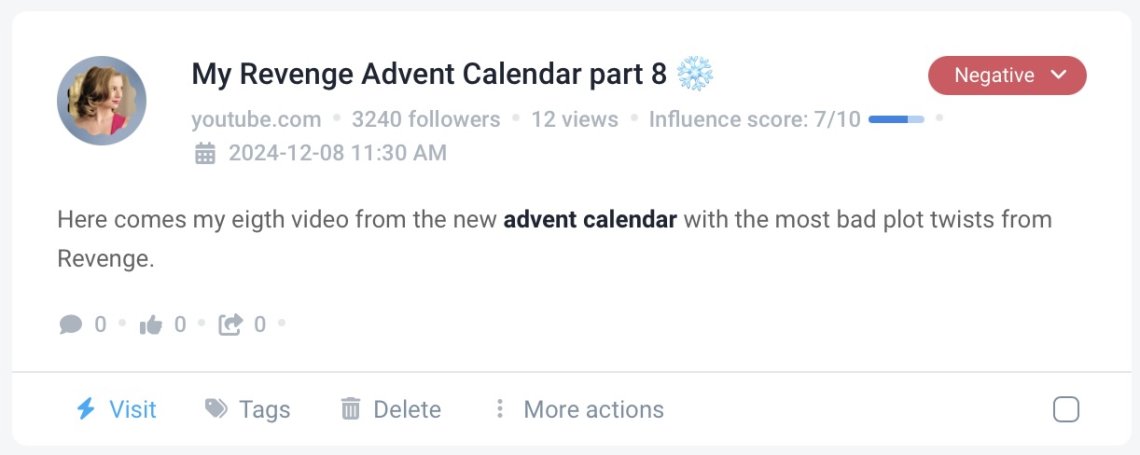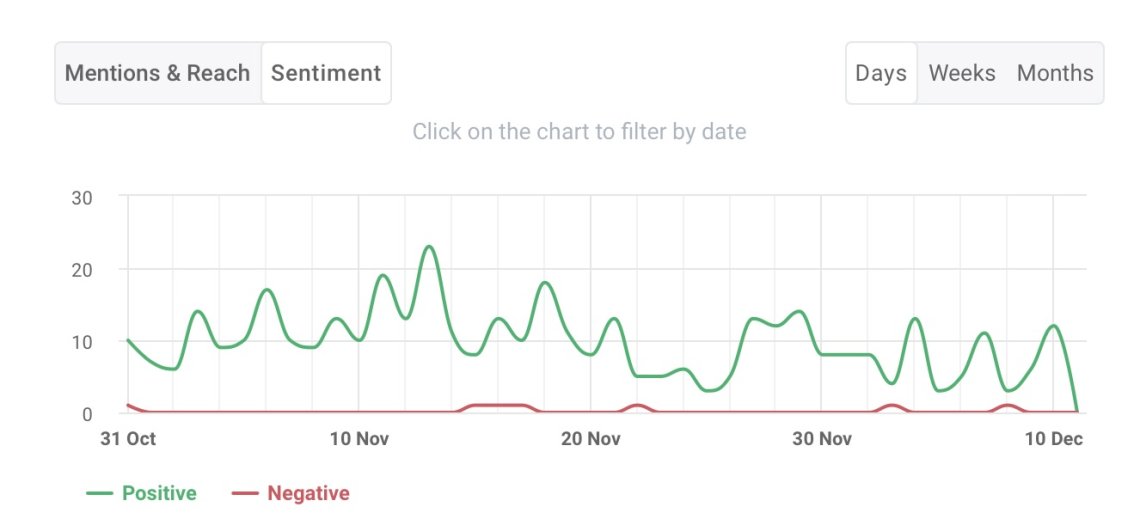How to Do YouTube Sentiment Analysis? Example & Guide
Table of contents
Christmas is coming, which means it’s time for advent calendars and unboxing videos on YouTube! In just a few days this December, the hashtag #adventcalendar has been mentioned 9,246 times, reaching 114 million people. The sentiment around advent calendars on YouTube is overwhelmingly positive, with over 35% positive mentions and just 1.5% negative.
Thanks to YouTube sentiment analysis, you can uncover the potential behind the target emotions and make the most of these seasonal trends!
YouTube sentiment analysis identifies the feelings and attitudes behind each post, comment, or other interaction on YouTube as positive, negative, or neutral. It’s an effective way to understand what people say about you, your brand, or your competitors.
The most important thing is to watch the situation and react at the perfect moment to catch the viewers’ attention or to prevent a crisis.
I’ll show you how to perform sentiment analysis.
Let’s dive in!
What is YouTube sentiment analysis?
In 2024, YouTube had over 2.5 billion views and was still growing.
As you see, millions of YouTube comments are created every day. Sentiment analysis is a way to collect all those interactions linked with your brand to understand the emotions that stay behind them.
Simply identify whether the sentiment is.
A positive comment on YouTube

A negative comment on YouTube

Try the best YouTube sentiment analysis tool!
Why is it important?
In short, sentiment analysis is like a code that accurately determines the audience’s preferences and better understands the public’s sentiment.
It allows you to:
- Understand customer emotions – Uncover how people truly feel about your brand or content. This will help you connect with your target on a deeper level!
- Better communication – Tailor your tone and messaging based on users’ feedback. This will help you reach a broader viewers!
- Early problem detection – With sentiment analysis, you can spot negative trends before they escalate into bigger crises.
- Boost engagement – Focus on the topics and issues that really resonate with the target.
- Strengthen your brand’s reputation – Address concerns while highlighting positive feedback.
How do you do YouTube sentiment analysis?
People leave millions of YouTube comments every day.
You can search for each comment to analyze sentiment and create a Google sheet with all YouTube data.
If you are lucky, you will only have to spend hours analyzing all the comments. However, even if you spend many hours, you may miss some of them in the flurry of extracted comments and notifications.
Fortunately, another way to make it is to use a sentiment analysis tool!
Especially on a large scale. These tools can collect all mentions related to your brand and, with the help of AI, analyze YouTube comments and categorize them using a sentiment analysis algorithm, providing you with accurate, actionable insights.
However, it’s important to note that, like any AI, it’s not perfect yet and is still learning. This means that sarcasm, slang, or emojis can sometimes pose challenges for accurate analysis.
Try the best YouTube sentiment analysis tool!
YouTube sentiment analysis example
It’s time to see how it works in practice!
I’m sure most of us are familiar with creating an Excel spreadsheet to analyze YouTube sentiment—just copy-paste the comments and add a column next to them. Then, you start adding search keywords like “like,” “expensive,” “cheap,” “worth,” etc.
After that, you just hope there aren’t thousands of errors to fix manually!
I want to show you how to speed up the YouTube comment sentiment analysis process.
With the right tools, I promise that “sentiment analysis” will no longer sound scary or complicated!
Here’s how you can do it in 6 easy steps using Brand24 – AI-powered media monitoring tool:
Step 1: Set up the monitoring project and collect data
Start by opening a project. Choose the keyword you want to track; it can be anything:
- Your/your competitor’s brand name
- Hashtag
- Industry name
- Event/campaign
- Any other keyword!
On the right side, you can select the social media platforms where you want to search for data – Yes, all leading platforms are available, not just YouTube!
And the best part? You can easily find user-generated content without having to search for it.
December has arrived, and thus, for fans of beauty brands, the advent calendar period has begun.
So, let’s check out the sentiment behind the advent calendar from Fenty Beauty on YouTube!

As you can see, after filtering the Brand24 tab, I see only positive reviews of Fenty Beuty. In addition, to see only comments on the calendar, I typed keywords at the top to suspend the search.
But this is just the beginning of what media monitoring can offer.
You can dive much deeper into internal data, such as:
- Influence score – the higher the influence score, the greater the influence of a positive review.
- Relevance – Use this filter to display only the most relevant reviews, prioritizing those most likely to have the most significant impact on your audience.
- Intent – Select specific goals to analyze, such as customer satisfaction, purchase intent, or brand loyalty, to focus on what is most important.
Step 2: Check the sentiment breakdown
Alright, let’s get deeper into YouTube sentiment analysis!
In the Mentions tab, simply change the chart view to Sentiment. You’ll see two lines there: green for positive sentiment and red for negative.

Fenty Beuty’s calendar is getting good. Great job!
But let’s get into a deeper sentiment analysis.
Check the analysis tab, where you will find the sentiment breakdown chart.

The sentiment analysis results look promising. Out of 623 YouTube mentions, more than 230 are positive, while only 11 were identified as negative.
Most of the YouTube comments were neutral, as they mostly mentioned different variants of calendars prepared by other brands and price requests.
Step 3: Discover the exact emotions
Sentiment analysis on YouTube comments is not just about categorizing reviews.
With Brand24, you can explore specific emotions: admiration, joy, sadness, anger, disgust, and fear.

(neutral emotions are excluded)
These valuable insights will help you build strong customer relationships and improve your marketing strategies based on internal data.
This sentiment analysis offers key consumer insights into what viewers think and feel based on their comments and content related to your brand on YouTube.
Emotions play a key role here. By monitoring both positive and negative comments, you can refine your strategies and improve your marketing approach.
With Emotion Analysis, you get:
- A pie chart that breaks down the contribution of each emotion so you can quickly see which feelings are driving the video content and users’ comments.
- A line graph showing how your viewers’ emotions change over time.

Here, you can see that emotions change over time.
Understand your customer sentiments!
Step 4: Check the emojis
However, YouTube comments are not the only ones that analyze sentiment!
It’s worth mentioning that emotions are often conveyed through emojis. Surprisingly, they can reveal a lot about the current sentiment and trends surrounding your brand.
Let’s take a look at emoji analysis around the Fenty Beauty calendar:

Looks pretty good, doesn’t it? The most commonly used one is ” ✨” —not surprising, just Shine bright like a diamond!
Step 5: Dive into topics
We need to know the context if we want to analyze sentiment on YouTube videos and comments.
Understand what our viewers are discussing now and what is important to them.
Finally, a brand needs to be customer-centric to improve its sentiment. Customize upcoming products, campaigns, and content on YouTube.
At this point, all other sentiment analysis methods, such as coding or sentiment analysis machine learning, will fail or last forever.
Head to the Topic Analysis tab, where you’ll find the key topics and their stats.
Now, let’s take a closer look at the topic that sparked the most, “Beauty Industry Business”:

The topic evokes a great response! 45% positive, 54% neutral, and just 1% negative—what a fantastic sentiment score!
If you click “more status,” you’ll get a detailed report analyzing each topic!

This will include:
- Intent share – to understand user motivations
- Context – for a deeper look at the conversation
- Top mentions – highlighting key references
- Emojis – to analyze the emotional tone
This data can be used to analyze user engagement and gain insight into user input, allowing you to create more effective strategies and accurately perform sentiment analysis.
Step 6: Detect influencers
What is the most influential content on YouTube? It’s created by… influencers!
With the help of social listening tools, you can easily find the right ones—those with the most influence and reach—to boost your brand visibility and tap into new potential customers.
Look how easy it is!

As you can see, Brand24 provides you with a full list of the most impactful influencers.
You can check their mentions, reach, followers, share of voice, and overall influence score to quickly choose the best one to partner with.
Step 7: Track the sentiment over time
Nothing lasts forever, so regular YouTube monitoring is key to keeping the sentiment on point.
It’s like caring for your car – you don’t want to let it slide.
If you skip it too long, you might pay a lot to fix things. You could discover you’ve missed many small signs pointing to a bigger issue.
So, make it part of your weekly routine to check in and analyze YouTube comments to understand public sentiment.
By tracking all the comments, you can tweak your content and avoid wasting time or money on stuff that’s not hitting the mark. This way, you can create content that resonates with your viewers and avoid any drama down the line.

Sure, the calendar made some waves, but the buzz of the Arcane collection launch was more impactful. That gives Fenty Beuty solid brand insights into what the target is vibing with and how to play its marketing and product strategy next year.
And don’t forget both positive and negative comments matter. Sentiment can flip quickly, especially if a big-name influencer drops a negative review.
Why should you monitor YouTube sentiment regularly?
- Data processing helps track how comments about emotions change over time, which can provide insights into target reactions and emerging trends.
- It allows you to evaluate the effectiveness of your communication strategy or PR campaigns through detailed sentiment scores.
- Spot potential issues early and respond quickly to protect your reputation, preventing minor problems from escalating.
Your sentiment is changing right now!
Check it out!
Conclusion
YouTube sentiment analysis allows you to understand how your target feels about your brand, content, and products in real time.
You can track positive, negative, and neutral mentions in YouTube comments thanks to media monitoring tools. Providing valuable insights into the effectiveness of your communication strategies.
This lets you spot potential issues early and improve engagement and brand awareness.
Whether launching a product, running a campaign, or simply looking to connect with your target, sentiment analysis helps you tailor your approach, build stronger relationships, and stay ahead.
Final thoughts:
- Be regular: Track YouTube comments often to catch shifts in sentiment early.
- Be careful: Manual sentiment analysis often misses untagged mentions, leaving gaps in your insight. With the right tool, you capture all relevant feedback.
- Track emotions at scale: AI-powered tools like Brand24 monitor YouTube comments and uncover audience sentiment trends.
- Protect your brand reputation: By monitoring sentiment, you can manage your brand’s image and respond proactively to any emerging issues.
Ready to check your YouTube sentiment right now? Start your Brand24 14-day trial and see how easy it can be!



